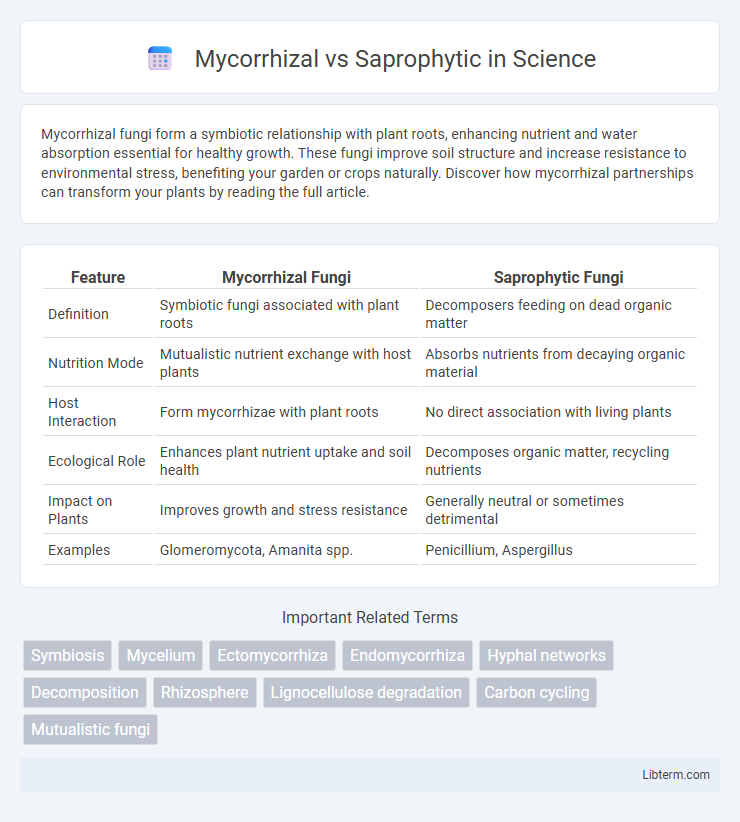Mycorrhizal fungi form a symbiotic relationship with plant roots, enhancing nutrient and water absorption essential for healthy growth. These fungi improve soil structure and increase resistance to environmental stress, benefiting your garden or crops naturally. Discover how mycorrhizal partnerships can transform your plants by reading the full article.
Table of Comparison
| Feature | Mycorrhizal Fungi | Saprophytic Fungi |
|---|---|---|
| Definition | Symbiotic fungi associated with plant roots | Decomposers feeding on dead organic matter |
| Nutrition Mode | Mutualistic nutrient exchange with host plants | Absorbs nutrients from decaying organic material |
| Host Interaction | Form mycorrhizae with plant roots | No direct association with living plants |
| Ecological Role | Enhances plant nutrient uptake and soil health | Decomposes organic matter, recycling nutrients |
| Impact on Plants | Improves growth and stress resistance | Generally neutral or sometimes detrimental |
| Examples | Glomeromycota, Amanita spp. | Penicillium, Aspergillus |
Introduction to Mycorrhizal and Saprophytic Fungi
Mycorrhizal fungi form symbiotic relationships with plant roots, enhancing nutrient and water uptake essential for plant growth and soil health. Saprophytic fungi decompose dead organic matter, recycling nutrients back into the ecosystem and maintaining soil fertility. Both types play critical roles in ecological balance and nutrient cycling within terrestrial environments.
Defining Mycorrhizal Fungi
Mycorrhizal fungi form symbiotic associations with plant roots, enhancing nutrient and water absorption in exchange for carbohydrates. These fungi penetrate or envelop root structures, facilitating vital nutrient exchange, particularly phosphorus, to support plant growth. Unlike saprophytic fungi, which decompose organic matter independently, mycorrhizal fungi rely on living plants for carbon sources.
Understanding Saprophytic Fungi
Saprophytic fungi play a crucial role in ecosystems by decomposing dead organic matter, thereby recycling nutrients back into the soil. Unlike mycorrhizal fungi, which form mutualistic associations with plant roots to exchange nutrients, saprophytic fungi extract energy from decaying plant and animal material independently. Key genera such as *Penicillium*, *Aspergillus*, and *Trichoderma* are prominent saprophytes that contribute to soil fertility and organic matter breakdown.
Key Differences Between Mycorrhizal and Saprophytic Fungi
Mycorrhizal fungi form symbiotic relationships with plant roots, enhancing nutrient uptake like phosphorus and nitrogen in exchange for carbohydrates from the plant. Saprophytic fungi decompose organic matter independently, breaking down dead plants and animals to recycle nutrients into the ecosystem. The primary difference lies in mycorrhizal fungi's mutualistic interaction with living plants, whereas saprophytic fungi obtain nutrients solely from non-living organic material.
Ecological Roles in Natural Ecosystems
Mycorrhizal fungi establish symbiotic relationships with plant roots, enhancing nutrient uptake and soil health, which supports plant growth and ecosystem stability. Saprophytic fungi decompose dead organic matter, recycling nutrients back into the soil and maintaining ecosystem nutrient cycles. Together, these fungi drive essential processes that sustain biodiversity and ecosystem productivity in natural environments.
Nutrient Cycling: Symbiosis vs. Decomposition
Mycorrhizal fungi enhance nutrient cycling by forming symbiotic relationships with plants, facilitating the exchange of essential minerals like phosphorus and nitrogen directly from soil to roots. Saprophytic fungi contribute to nutrient cycling through decomposition, breaking down organic matter and releasing nutrients back into the soil for plant uptake. The contrasting roles of mycorrhizal and saprophytic fungi create a balanced ecosystem by supporting plant growth and maintaining soil fertility.
Plant-Fungi Interactions and Benefits
Mycorrhizal fungi form symbiotic associations with plant roots, enhancing nutrient uptake, particularly phosphorus, and improving plant growth and resilience against environmental stresses. In contrast, saprophytic fungi decompose organic matter, recycling nutrients back into the soil, which indirectly benefits plants by maintaining soil fertility. Both fungi types play crucial roles in ecosystem nutrient cycling, but mycorrhizal fungi have a direct symbiotic relationship that significantly boosts plant health and productivity.
Habitat Preferences and Distribution
Mycorrhizal fungi predominantly inhabit forest ecosystems, forming symbiotic relationships with the roots of trees and plants, which facilitates nutrient exchange and supports plant growth. Saprophytic fungi thrive in environments rich in decaying organic matter such as leaf litter, dead wood, and soil, where they decompose complex organic compounds to recycle nutrients. Distribution of mycorrhizal fungi correlates with host plant presence, while saprophytic fungi exhibit broader habitat tolerance due to their independent nutrient acquisition from dead material.
Implications for Agriculture and Horticulture
Mycorrhizal fungi form symbiotic relationships with plant roots, enhancing nutrient uptake, improving soil structure, and increasing drought resistance, which boosts crop productivity and reduces the need for chemical fertilizers in agriculture and horticulture. Saprophytic fungi decompose organic matter, recycling nutrients back into the soil and supporting sustainable soil health management, crucial for maintaining long-term fertility and reducing reliance on synthetic inputs. Integrating both mycorrhizal and saprophytic fungi in cultivation practices promotes resilient ecosystems, improved plant growth, and sustainable resource use.
Conclusion: Choosing the Right Fungi for Sustainability
Selecting mycorrhizal fungi enhances plant nutrient uptake and soil health, promoting sustainable agriculture through symbiotic relationships with roots. Saprophytic fungi are essential for decomposing organic matter and recycling nutrients, supporting ecosystem balance and soil fertility. Integrating both fungi types optimizes sustainability by combining nutrient acquisition and organic matter breakdown for resilient, productive soils.
Mycorrhizal Infographic

 libterm.com
libterm.com